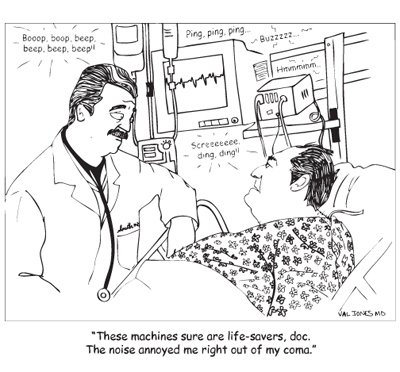February 25th, 2010 by Medgadget in Better Health Network, News, Research
No Comments »

 From RIKEN Research:
From RIKEN Research:
Scientists from RIKEN Brain Science Institute in Wako, Japan and the Institute of Neurology at University College London have discovered that the brains of macaque monkeys undergo significant development when they are taught how to use tools. This finding may imply that our advanced human brains got as big and powerful as they did thanks to using tools, rather than the other way around.
The researchers used a technique called voxel-based morphometry (VBM) to classify areas of brain tissue in their MRI images as grey matter, white matter, or cerebro-spinal fluid, and to compare the volume of each tissue at different stages of learning. Read more »
*This blog post was originally published at Medgadget*
February 19th, 2010 by Medgadget in Better Health Network, News, Research
No Comments »

 Have Caltech scientists discovered an area of the brain evolved since the development of currency? The headline effectively suggests that, but the truth is probably a bit more nuanced.
Have Caltech scientists discovered an area of the brain evolved since the development of currency? The headline effectively suggests that, but the truth is probably a bit more nuanced.
The research team responsible for these findings consists of Benedetto de Martino, a Caltech visiting researcher from University College London and first author on the study, along with Caltech scientists Colin Camerer, the Robert Kirby Professor of Behavioral Economics, and Ralph Adolphs, the Bren Professor of Psychology and Neuroscience and professor of biology.
The study involved an examination of two patients whose amygdalae had been destroyed due to a very rare genetic disease; those patients, along with individuals without amygdala damage, volunteered to participate in a simple experimental economics task. Read more »
*This blog post was originally published at Medgadget*
February 11th, 2010 by Medgadget in Better Health Network, News, Research
No Comments »

 New cancer targeting nanoparticles seem like daily news here at Medgadget. Today we have gold nanoparticles developed jointly by researchers at Rice University and A.V. Lykov Heat and Mass Transfer Institute in Minsk, Belarus that create plasmonic nanobubbles when targeted with a laser. These particles can be guided to a tumor by antibodies and then activated to generate tiny explosions, so clinicians one day will be able to stay back and enjoy. Read more »
New cancer targeting nanoparticles seem like daily news here at Medgadget. Today we have gold nanoparticles developed jointly by researchers at Rice University and A.V. Lykov Heat and Mass Transfer Institute in Minsk, Belarus that create plasmonic nanobubbles when targeted with a laser. These particles can be guided to a tumor by antibodies and then activated to generate tiny explosions, so clinicians one day will be able to stay back and enjoy. Read more »
*This blog post was originally published at Medgadget*
February 4th, 2010 by Medgadget in Better Health Network, News
1 Comment »

 First Aid Corps, an organization working on helping the public respond to sudden cardiac arrests, has unveiled an iPhone app that can pinpoint the location of the closest automatic external defibrillator (AED) within seconds.
First Aid Corps, an organization working on helping the public respond to sudden cardiac arrests, has unveiled an iPhone app that can pinpoint the location of the closest automatic external defibrillator (AED) within seconds.
Currently the database is just beginning to fill up but First Aid Corps has partnered with The Extraordinaries, a volunteer organization, to have people locate and photograph AED’s in their community.
The app is free and you can download it and get started mapping AED’s and maybe help save someone’s life.
Here’s a promo video for the project:
Demo of the AED Nearby app:
AED Nearby iTunes link…
Flashbacks: AED Location Database Points to Nearest Life Saving Device; Do You Know Where Your AED Is At?
*This blog post was originally published at Medgadget*
 From RIKEN Research:
From RIKEN Research:


 Have Caltech scientists discovered an area of the brain evolved since the development of currency? The headline effectively suggests that, but the truth is probably a bit more nuanced.
Have Caltech scientists discovered an area of the brain evolved since the development of currency? The headline effectively suggests that, but the truth is probably a bit more nuanced. New cancer targeting nanoparticles seem like daily news here at Medgadget. Today we have gold nanoparticles developed jointly by researchers at Rice University and A.V. Lykov Heat and Mass Transfer Institute in Minsk, Belarus that create plasmonic nanobubbles when targeted with a laser. These particles can be guided to a tumor by antibodies and then activated to generate tiny explosions, so clinicians one day will be able to stay back and enjoy.
New cancer targeting nanoparticles seem like daily news here at Medgadget. Today we have gold nanoparticles developed jointly by researchers at Rice University and A.V. Lykov Heat and Mass Transfer Institute in Minsk, Belarus that create plasmonic nanobubbles when targeted with a laser. These particles can be guided to a tumor by antibodies and then activated to generate tiny explosions, so clinicians one day will be able to stay back and enjoy.  First Aid Corps, an organization working on helping the public respond to sudden cardiac arrests, has unveiled an iPhone app that can pinpoint the location of the closest automatic external defibrillator (AED) within seconds.
First Aid Corps, an organization working on helping the public respond to sudden cardiac arrests, has unveiled an iPhone app that can pinpoint the location of the closest automatic external defibrillator (AED) within seconds.








